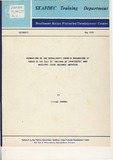Estimation of the Bertalanffy Growth Parameters of Fishes in the Gulf of Thailand by Unweighted of Weighted least Squares Methods
Abstract
Three probabilistic models are postulated under the assumptions that the error terms are additive and that the length variances are constant for all ages in Model 1, the variances are proportional to the square roots of the expected lengths in Model 2 and the variances are proportional to the expected lengths in Model 3. These assumptions lead to the unweighted nonlinear regression in Model 1, the weighted nonlinear regression with the weighting factor of, in practice, the reciprocal of the estimated lengths and the reciprocal of the squares of the estimated lengths in Models 2 and 3 respectivelay.
Eight data sets of marine fishes, one pelagic and three demersal species, are used to estimate the Bertalanffy growth parameters. The results of the estimations and analyses are closely examined and discussed. These include the magnitude changes of the estimates and their variance, the variability indices and the approximate t-tests, the coefficients of determination, the computed first partial derivatives of the residual sums of squares with respect to the parameters with the final estimates in place of the parameters and the residual analyses.
The examinations of these estimations and analyses reveal that, in general, the proposed weighting factors in Model 3 result in the better determined; especially those of K and to . But the estimates of Loo are equally highly precise and they are equally very highly determined in all models. The other results also suggest that the basic concepts and assumptions behind the least squares method and the error terms, zero mean and unity variance for the ratios of errors to the standard deviation, are better fulfilled in model 3 than in the other two models. Thus, Model 3 is likely to be suitable for the age-length data of many species of fishes in which the variances of the lengths tend to be higher in larger fish. It is concluded that Model 3, in which the additive error is proportional to the expected length and hence the estimated length in practice, is the most superior one and should be used to represent the probabilistic Bertalanffy growth model.
Subject
Collections
- Fishery Biology [22]

